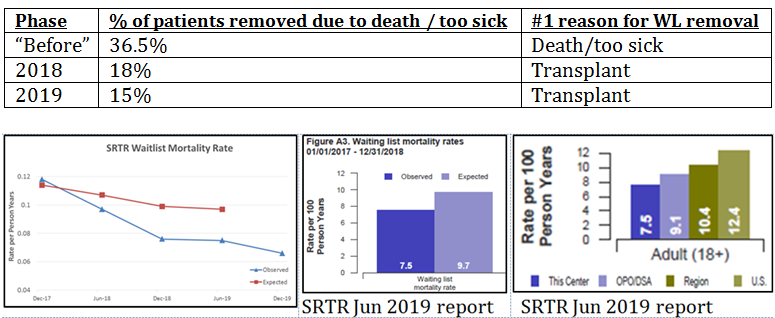Improving Liver Transplant (LT) Waitlist Attrition
1Stanford University Medical Center, Palo Alto, CA, 2Stanford Health Care, Palo Alto, CA
Meeting: 2020 American Transplant Congress
Abstract number: 386
Keywords: Liver, Waiting lists
Session Information
Session Name: Quality Assurance Process Improvement & Regulatory Issues II
Session Type: Oral Abstract Session
Date: Saturday, May 30, 2020
Session Time: 3:15pm-4:45pm
 Presentation Time: 3:51pm-4:03pm
Presentation Time: 3:51pm-4:03pm
Location: Virtual
*Purpose: LT patients are listed with the goal of receiving a transplant. Jan-2018 SRTR report showed that our observed waitlist (WL) mortality rate was 11.8 per 100 person years (ppy), higher than the expected of 11.4/ppy and higher than our OPO rate of 11.7/ppy. Only 36% of the 181 WL removals in one year were removed for transplantation. An additional 36.5% of patients either “died” on the list or were “too sick” at WL removal.Our program completed a study and analyzed removal reasons and patient characteristics to improve WL mortality and attrition.
*Methods: Initially, we reviewed MELD scores of patients removed for death & too sick reasons. Surprisingly, 1/3 of patients had low MELD (lM) (<20) scores. We completed chart reviews to understand causes resulting in undesired outcomes. Following factors contributing factors were identified: 1. access; 2. patient mgmnt/regular check-ins, especially for patients seen at outreach clinics, candidacy reassessment, follow-ups; 3. clinical factors, such as stroke, deconditioning/frailty, diabetes. To increase access, program started a new NP clinic. To improve patient mgmnt/follow-up, standard work was developed for outreach clinics, standardized documentation was created; clinic schedules/ after visit summaries were shared with coordinators for greater effectiveness in care coordination. To ensure all patients, including lM patients are being contacted and updated labs are received, program manager (PM) implemented a visual mgmnt system to track progress. In addition, program developed a protocol, requiring lM patients to be seen in clinic at a min of every 6m. The program also focused on health maintenance and candidacy reassessment through collaboration with internal medicine. The new LT Wellness Clinic was implemented and included full check-up and annual health maintenance.
*Results: Program monitored N & % of expired MELD scores process metric, as a proxy to regular check-ins. At the beginning 24% of the patients (mostly inactive and low MELD) had expired MELD scores, after implementation of the various interventions, only 6% of the patients had expired MELD scores, actively being tracked on the PM’s viz board. Outcome metrics included: 1. WL attrition, internally defined as % of patients removed due to death/too sick 2. SRTR WL mortality
*Conclusions: Program’s quality initiative resulted in interventions that enhanced WL management strategies and significantly improved WL attrition and mortality. Program has achieved the lowest mortality rate over the last 5 years that is also better than the OPO, Region and US.
To cite this abstract in AMA style:
Concepcion W, Ahmed A, Tulu Z, Hogan L, Bonham A, Gallo A, Melcher M, Kwo P, Esquivel C. Improving Liver Transplant (LT) Waitlist Attrition [abstract]. Am J Transplant. 2020; 20 (suppl 3). https://atcmeetingabstracts.com/abstract/improving-liver-transplant-lt-waitlist-attrition/. Accessed December 16, 2025.« Back to 2020 American Transplant Congress

